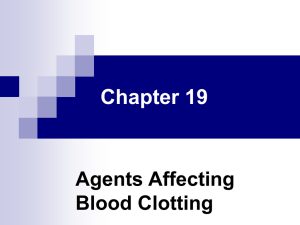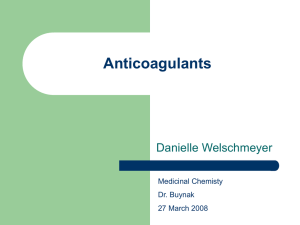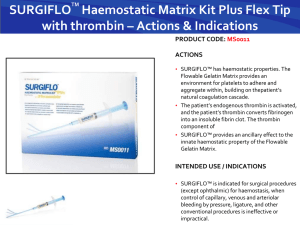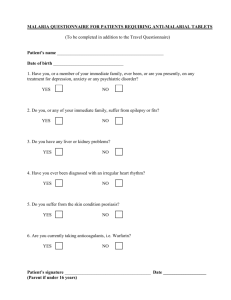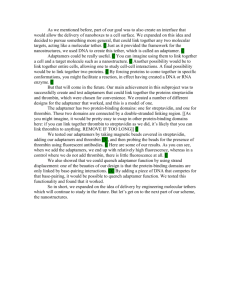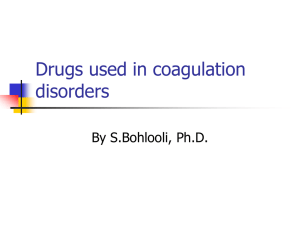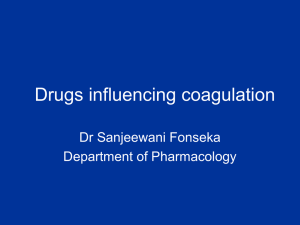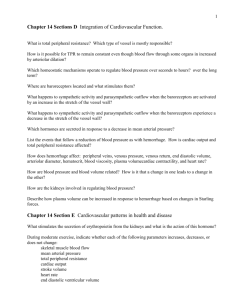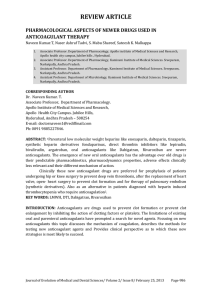Anticoagulants are agents that prevent the formation of blood clots
advertisement
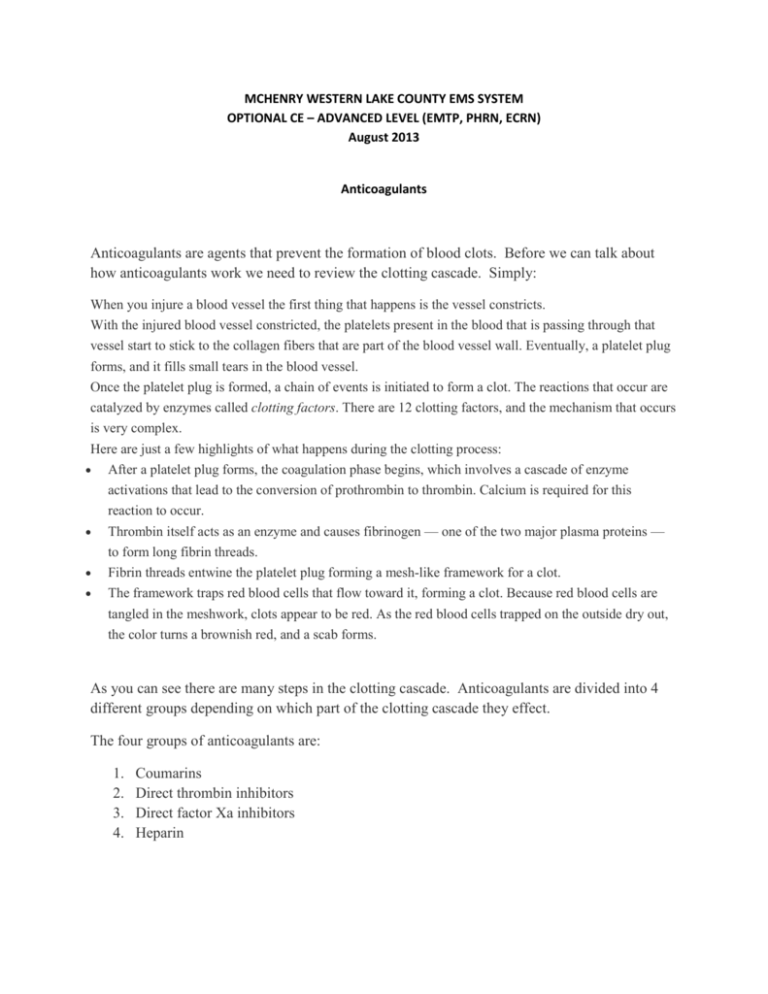
MCHENRY WESTERN LAKE COUNTY EMS SYSTEM OPTIONAL CE – ADVANCED LEVEL (EMTP, PHRN, ECRN) August 2013 Anticoagulants Anticoagulants are agents that prevent the formation of blood clots. Before we can talk about how anticoagulants work we need to review the clotting cascade. Simply: When you injure a blood vessel the first thing that happens is the vessel constricts. With the injured blood vessel constricted, the platelets present in the blood that is passing through that vessel start to stick to the collagen fibers that are part of the blood vessel wall. Eventually, a platelet plug forms, and it fills small tears in the blood vessel. Once the platelet plug is formed, a chain of events is initiated to form a clot. The reactions that occur are catalyzed by enzymes called clotting factors. There are 12 clotting factors, and the mechanism that occurs is very complex. Here are just a few highlights of what happens during the clotting process: • After a platelet plug forms, the coagulation phase begins, which involves a cascade of enzyme activations that lead to the conversion of prothrombin to thrombin. Calcium is required for this reaction to occur. • Thrombin itself acts as an enzyme and causes fibrinogen — one of the two major plasma proteins — to form long fibrin threads. • Fibrin threads entwine the platelet plug forming a mesh-like framework for a clot. • The framework traps red blood cells that flow toward it, forming a clot. Because red blood cells are tangled in the meshwork, clots appear to be red. As the red blood cells trapped on the outside dry out, the color turns a brownish red, and a scab forms. As you can see there are many steps in the clotting cascade. Anticoagulants are divided into 4 different groups depending on which part of the clotting cascade they effect. The four groups of anticoagulants are: 1. 2. 3. 4. Coumarins Direct thrombin inhibitors Direct factor Xa inhibitors Heparin Coumarins Warfarin (trade name: Coumadin) is the main drug listed in this category. It works by inhibiting Vitamin K expoxide reluctase, an enzyme that recycles oxidized vitamin K. Vitamin K is an activator of coagulating factors II, VII, IX and X, so by decreasing the availability of Vitamin K synthesis of these factors are decreased. Warfarin is used to treat blood clots in cases of deep vein thrombosis or pulmonary embolism. It is also used to prevent thrombosis in patients at high risk such as atrial fibrillation, heart attack, and knee or hip surgery. Warfarin is taken orally. The dose varies and is regulated by the patient’s INR level. This requires monthly blood testing. It’s half life is 36 hours and its primary route of elimination is the liver. Patients must be careful with their diet making sure their Vitamin K intake remains constant. The primary adverse effect associated with warfarin is bleeding. This effect is reversible using Vitamin K and fresh frozen plasma. Direct Thrombin Inhibitors Dabigatran (trade name Pradaxa) is the most commonly found drug in this category. Thrombin inhibitors are anticoagulants that bind to and inhibit the activity of thrombin therefore prevent blood clot formation. Thrombin inhibitors inactivate free thrombin and also the thrombin that is bound to fibrin. Thrombin has many important functions in the clotting pathway, so it is a good target for anticoagulants drugs. Thrombin inhibitors are used to prevent arterial and venous thrombosis. They can be used to prevent and treat deep vein thrombosis, or used as prophylaxis in atrial fibrillation to avoid thromboembolism. Dabigatran is taken orally. The dose is 150mg twice daily (75mg twice daily for people with renal impairment. It does not affect a patient’s INR and monthly monitoring is not necessary. The half life of the drug is 12 – 17 hours and it primarily eliminated by the kidneys. This medicine is not affected by diet. Adverse effects may include bleeding and indigestion or stomach upset. Unlike warfarin there is no reversal agent for this medication in the case of major bleeding. Direct Factor Xa Inhibitors. Rivaroxaban (trade name Xarelto) is the most commonly found drug in this category. Factor Xa inhibitors are anticoagulants that block the activity of clotting factor Xa and prevents blood clots developing or getting worse. Factor Xa is generated by both the extrinsic and intrinsic coagulation pathways, it activates prothrombin to thrombin, which activates the final components of the coagulation pathway to form clots. Factor Xa inhibitors are generally used as prophylaxis in patients having hip and knee replacement surgery, where blood clots can form and lead to deep vein thrombosis and pulmonary embolism. It is also used for the prevention of stroke/systemic embolism in patients with non-valvular atrial fibrillation. Rivaroxaban is taken orally. The dose is 10mg once daily for the prevention of thromboembolism and 20mg once daily for the patient with atrial fibrillation. Just like Dabigatran the patient’s INR is not affected so monthly lab work is not necessary. The half life is 5 – 13 hours and is eliminated by the kidneys and liver. This medicine is not affected by diet. Adverse effects are bleeding. There is not reversal agent for this medication in the case of major bleeding. Heparin Heparin is an injectable anticoagulant that activates antithrombin III, which inhibits thrombin and factor Xa, factors necessary in the final stages of blood clotting cascade. There are two types of heparins: high molecular weight heparins and low molecular weight heparins. High molecular weight heparins require daily blood monitoring to check the aPTT. Low molecular weight heparins such as Enoxaparin (trade name Lovenox) give a better anticoagulant response and do not need daily blood monitoring. Heparin is used to treat or prevent clots in conditions where there is a high risk of clot formation and thromboembolism, such as in atrial fibrillation, myocardial infarction, deep vein thrombosis, knee and hip surgery and so on. Dosage and half life varies depending on whether high or low molecular heparin is used. Drugs in this group unlike the other anticoagulants is given by injection. Major adverse effects are bleeding and thrombocytopnea. In the case of major bleeding the drug protamine may be used to reverse the effects. McHenry Western Lake County EMS System OPTIONAL CE – ADVANCED LEVEL (EMTP, PHRN, ECRN) August 2013 Anticoagulants Name: _________________________ Date: _________________________ Dept: ____________________________________ 1. List the 4 groups of anticoagulants A. ____________________ B. ____________________ C. ____________________ D. ____________________ 2. The generic name for Coumadin is ________________________. 3. List 2 indications for the use of anticoagulants. __________________________________, ________________________________ 4. A major side effect of all anticoagulants is ____________________________. 5. The most common Direct Thrombin inhibitor is _____________________________. 6. _________________ is the drug that requires monthly lab testing to determine the patient’s INR. 7. Drugs in this group are given by injection. ________________________. 8. There is no reversal agent for drugs in these two groups of anticoagulants: ____________________________ and ____________________________ 9. The most common Direct Factor Xa Inhibitor is _____________________________. 10. All anticoagulants affect the same part of the clotting cascade. True False.
